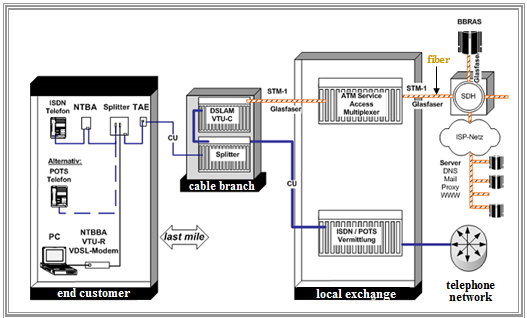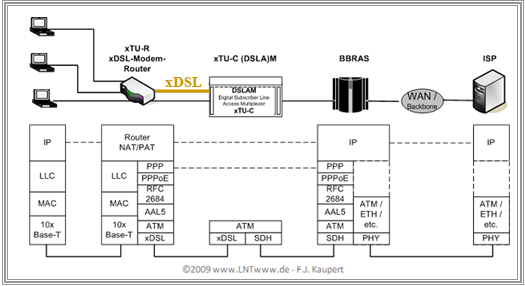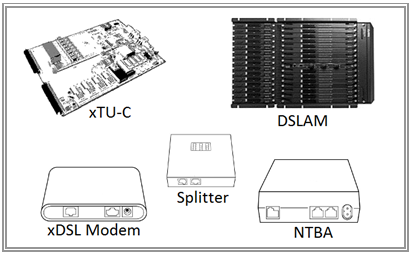xDSL Systems
Contents
- 1 Reference models
- 2 Overview and common features of all xDSL systems
- 3 ADSL – Asymmetric Digital Subscriber Line
- 4 ADSL2 and ADSL2plus
- 5 VDSL – Very–high–speed Digital Subscriber Line
- 6 DSL Internet access from perspective of the communication protocols
- 7 Components of DSL Internet access
- 8 Exercises for the chapter
Reference models
Based on the following general ITU reference model, it can be quickly seen that xDSL is physically a pure access transmission technology that is only used in the local loop network area between the fiber termination point and the network termination at the end customer.
The basic elements of the xDSL standard are:
- the network termination $\rm (NT)$,
- a subscriber line$\rm$, and
- the line termination $\rm (LT)$.
There is a lot of freedom for network operators in implementing this reference model in practice. What all previous implementations have in common is that they use existing metallic subscriber lines.
$\text{Examples 1:}$ In an example, the configuration most frequently encountered in Germany is shown according to the graphic. Note:
- In all xDSL variants deployed today, the data service converted in the modems is combined with the telephone service. This allows transmission over the existing telephone network.
- The "splitter" separate the signal on both sides of the subscriber line into the classes "broadband" and "narrowband" .
- An important interface is designated $\text{U-R2}$ $($red marking$)$.
- This was standardized in Germany in 2001 by Deutsche Telekom AG in order to be able to use any modems on the subscriber side.
- This means that the customer is no longer dependent on his provider's xDSL modem.
Overview and common features of all xDSL systems
The technical realization of an $\rm xDSL$ system involves many system components, which can be distributed over several localities. There is a wide range of realization options. To summarize $($from the perspective of 2009$)$:
- The systems for $\rm ADSL$ and $\rm ADSL$ shown below represent the most common implementation. Data transport at the protocol level is based on the $\rm ATM$ technology $($"Asynchronous Transfer Mode"$)$.
- Despite a large data overhead, ATM still offers advantages over "Ethernet" in terms of guaranteed quality of service $\rm (QoS)$, i.e. effective bit rate, low delay and jitter.
- Ethernet, on the other hand, enables very high data transmission rates, especially through the »10 Gbit/s Ethernet« and »100 Gbit/s Ethernet« $($"Metro Ethernet"$)$ variants. ATM, on the other hand, is more suitable for lower data rates.
- In 2009 there were numerous discussions about whether ATM should be replaced by "10 Gbit/s Ethernet" in the course of "Next Generation Network". However, upgrading the backbone from ATM to Ethernet represents a not inconsiderable investment.
$\text{Summary:}$ As mentioned in the chapter "General Description of DSL", the most commonly deployed xDSL variants
- $\rm ADSL$,
- $\rm ADSL2$ resp. $\rm ADSL2+$,
- $\rm VDSL(1)$
- $\rm VDSL(2)$
are defined in such a way that simultaneous operation of »POTS« $($"Plain Old Telephone Service"$)$ or »ISDN« $($"Integrated Services Digital Network"$)$ on the same line is possible at any time. This is the basis of the further descriptions.
ADSL – Asymmetric Digital Subscriber Line
The physical network termination $\rm (NT)$ is in the ADSL modem $($"ADSL Transmission Unit Central Office", $\text{ATU-C)}$ in the local exchange. Before that, in the "splitter" the low-frequency telephony spectrum is separated from the higher-frequency ADSL spectrum by low-pass and high-pass filtering.
The graphic shows an ADSL connection from the end customer to the local exchange, which is described very briefly below. The reverse data connection paths are in each case mirror-inverted.
- The splitter forwards the telephone signals to the ISDN/POTS exchange and the ADSL signals to the "digital subscriber line access multiplexer" $\rm (DSLAM)$, in which the "$\text{ATU-C}$" is implemented as a plug-in card.
- The DSLAM bundles many ADSL connections and forwards the data after decoding at the ATM level via optical fiber to the "ATM Service Access Multiplexer". This sends the data from all DSLAMs over the backbone to the "Broadband Remote Access Server" $\rm (BBRAS)$.
- The BBRAS terminates the point-to-point protocol data link and forwards the IP packets via routers to the destination. The backbone consists of optical components based on $\rm SDH$ standard $($"Synchronous Digital Hierarchy"$)$.
- The splitter connected to the "telecommunications connection unit" $\rm (TAE)$ separates the signals.
- The telephone signals are routed to the telephony terminals, the ADSL signals to the modem $($"ADSL Transmission Unit Remote", $\text{ATU-R)}$. The modem decodes and forwards the binary data to the connected terminals.
- During initialization of the ADSL connection, $\text{ATU-C}$ and $\text{ATU-R}$ perform a so-called "training" in which relevant system parameters $($data rate, fast and interleaved mode, ...$)$ are determined depending on the line conditions.
- The parameters negotiated in this process are retained until the next check and synchronization. For the transmission of administrative data $($"overhead"$)$, $32$ kbit per frame are statically reserved in the ADSL systems.
ADSL2 and ADSL2plus
$\text{These two system variants are further developments of ADSL:}$
- The enhanced system variant "Asymmetric Digital Subscriber Line Transceivers 2" $\rm (ADSL2)$ was specified in 2002 with ITU recommendations $\rm G.992.3$, $\rm G.992.4$.
- 2003 followed by the ITU recommendation $\rm G.992.5$: "Extended-bandwidth ADSL2" $\rm (ADSL2+)$.
Compared to ADSL, the following changes occurred:
- In ADSL2, the "Seamless Rate Adaption" $\rm (SRA)$ was included in the standard. This allows transmission parameters to be changed during operation with time-variant channel quality without loss of synchronization.
- For this purpose, ATU-C and ATU-R periodically check the signal–to–noise ratio $\rm (SNR)$ of the transmission channels. If a channel in use deteriorates, the receiver notifies the transmitter of the new data rate and transmission level. After a subsequent "sync flag" the parameters are adopted.
- ADSL2 systems also offer a wide range of diagnostic options even without the modems having been synchronized, a feature that is particularly important for troubleshooting, error analysis and error correction.
- In addition, ADSL2 provides the ability to reduce transmit levels when SNR is sufficient, thereby minimizing crosstalk and increasing throughput in the trunk cable. This "power cutback" can be initiated not only by the DSLAM, but also by the ATU-R.
- In ADSL2, the number of overhead bits is no longer fixed, but can vary between $4$ and $32$ kbit. This increase in the user data bit rate of up to $28$ kbit/s per data frame is all the more important the longer the distance between the modem and the DSLAM.
$\text{As a result from 2009:}$
- $\text{ADSL2}$ systems achieve a transmission rate of more than $8$ Mbit/s $($up to $12$ Mbit/s$)$ downstream and more than $800$ kbit/s $($up to $3.5$ Mbit/s$)$ upstream.
- With $\text{ADSL2+}$, the transmission rate in the downstream is doubled again; the maximum rate is theoretically $25$ Mbit/s.
VDSL – Very–high–speed Digital Subscriber Line
In terms of the basic structure of their components, VDSL systems are identical to ADSL systems, with the only exception that the relocation of the splitter and the DSLAM from the local exchange to a cable branch makes the last section between the network operator and the customer, the so-called "last mile".
This measure was necessary because VDSL can only exploit its advantage – the greater transmission speed – over very short distances due to the attenuation of the higher frequencies, which increases sharply with line length.
DSLAM and BBRAS are still connected via $\text{STM-1}$ interfaces. Therefore, the route between the local exchange and the cable branch must now also be laid with optical fiber.
A distinction is made between two alternative VDSL variants:
- $\rm VDSL(1)$ is based on $\rm QAM$ $($"Quadrature Amplitude Modulation"$)$, which is predominantly deployed in Asia,
- $\rm VDSL(2)$ is based on $\rm DMT$ $($"Discrete Multitone Transmission"$)$.
- VDSL(1) systems were never deployed in Germany because of their inadequate ability to provide audio/video, telephony and Internet $($"triple play"$)$ with sufficient quality of service.
- Instead, the VDSL(2) standard was established immediately: Because of higher performance and greater range, the better quality of service as well as the reusability of the ADSL(2+) infrastructure.
$\text{Summary:}$ Following a few characteristics of the $\rm VDSL(2)$ system:
- VDSL(2) has achieved since 2006 a maximum transmission rate of $50$ to $100$ Mbit/s, depending on the standard used.
- The specified VDSL(2) transmission bandwidth of $30$ MHz was considered the maximum reasonable bandwidth in 2009.
- With complementary measures such as "Dynamic Spectrum Management" and "Advanced Codes" total transmission rates of up to $280$ Mbit/s were expected for short line lengths $($up to $300$ meters$)$.
DSL Internet access from perspective of the communication protocols
Some xDSL modems offer an Ethernet interface for connecting the data terminals and a transparent connection to the remote terminal, based on the "Internet Protocol" $\rm (IP)$. The following should be noted:
- This option is enabled by the "LAN Emulation" $\rm (RFC2684)$ and the "ATM Adaption Layer Protocol" $\rm (AAL5)$. The Ethernet data stream must be converted to $\rm ATM$ for this purpose.
- This eliminates the need to install ATM equipment and existing Ethernet hardware can be used, greatly simplifying xDSL configuration at the customer site.
- The ATM connection extends at least as far as the "Broadband Remote Access Server" $\rm (BBRAS)$ and is converted there or continued directly, depending on the backbone data transmission system.
The graph on the right shows the communication in an Internet connection according to the OSI model, where "xDSL" $($brown background$)$ is used only
- between the "TU-R" on the customer side $($here realized with an "xDSL router"$)$
- and the "TU-C" on the provider side.
Components of DSL Internet access
Finally, necessary components for a DSL connection are listed. The graph shows examples of these, mostly from "Deutsche Telekom".
$\rm NTBA$: The commonly used term is "Network Termination for ISDN Basic Rate Access". Tasks of the NTBA are:
- With help of a fork circuit and echo cancellation, the two-wire $\rm U_{K0}$ interface on the provider side is converted into the four-wire $\rm S_0$ interface on the subscriber side.
- In addition, the NTBA manages the ISDN code conversion from the "Modified Monitored Sum 4B3T" code $\rm (U_{K0}$ bus$)$ to the modified AMI code $\rm (S_{0}$ bus$)$.
$\text{xTU-R}$: The abbreviation stands for "xDSL Transceive Unit - Remote"' and denotes the subscriber-side xDSL unit.
- Due to the widespread use of Ethernet, today's xDSL modems and routers usually have only one Ethernet port for connecting data terminal equipment. Originally, they were used for subscriber-side connection of ATM data terminals.
- Thus, this unit must also perform the function of a "Layer 2 bridge" in order to be able to transmit Ethernet over ATM to the "Broadband Remote Access Server" (BBRAS) for termination.
$\text{xDSL modem}$: With this functional unit, the data connection from/to the data terminal is initialized by a "point-to-point protocol" $\rm (PPP)$ via a "PPP over Ethernet connection" and terminated by the "BBRAS". Only data terminal devices that can separately establish a data connection via PPP are eligible.
$\text{xDSL router}$: This initializes the data connection via PPP and enforces the addresses at IP level. This allows multiple terminals to be connected and allows internal data exchange between them without having to dial into them separately.
$\rm Splitter$: This is basically a combination of high-pass and low-pass with three interfaces, which handles the separation of the high-frequency xDSL data signals $($above $138$ kHz$)$ from the low-frequency POTS or ISDN telephone signals $($below $120$ kHz$)$, or their combination.
- This "broadband access unit" is nothing other than a crossover unit.
- The sum of the signals is present on the subscriber line side, while the xDSL data and the POTS/ISDN signals are separated from each other by a splitter on both the customer and provider sides.
$\text{xTU-C}$: The abbreviation stands for "xDSL Transceive Unit - Central office". It is the provider-side xDSL unit and is usually implemented as a printed-circuit board insertion for the DSLAM. The xTU-C terminates the physical retail xDSL subscriber lines, modulates the ATM bit stream on the subscriber side, and demodulates the xDSL signal on the provider side.
$\text{DSLAM}$: The abbreviation stands for "Digital Subscriber Line Access Multiplexer". In its simplest form, it terminates the physical subscriber lines with its xTU-C line cards. In an extended form, an "ATM Service Access Multiplexer" is also integrated in the DSLAM.
- The task of the DSLAM is to bundle the ATM bit streams of the subscriber lines and to forward them in concentrated form in the multiplexing process via an STM-1 fiber interface into the provider network.
- "STM" is an "synchronous digital hierarchy" $($SDH$)$ transmission standard for multiplexing optical channels and stands for "Synchronous Transport Module". STM-1 allows a bit rate of up to $155.52$ Mbit/s, STM-64 up to almost $10$ Gbit/s.
Exercises for the chapter
Exercise 2.2Z: DSL Internet Connection





